 BACKPACK GOURMET
BACKPACK GOURMET


BACKPACK GOURMET Good Hot Grub You Can
Make at Home, Dehydrate,
and Pack for Quick, Easy, and
Healthy Eating on the Trail

Linda Frederick Yaffe STACKPOLE
BOOKS Copyright 2002 by Linda Frederick Yaffe Published by STACKPOLE BOOKS 5067 Ritter Road Mechanicsburg, PA 17055 www.stackpolebooks.com All rights reserved, including the right to reproduce this book or portions thereof in any form or by any means, electronic or mechanical, including photocopying, recording, or by any information storage and retrieval system, without permission in writing from the publisher. All inquiries should be addressed to Stackpole Books, 5067 Ritter Road, Mechanicsburg, Pennsylvania 17055. Printed in the United States First Edition 10 9 8 7 6
Cover photograph by www.comstock.comCover design by Caroline StoverLibrary of Congress Cataloging-in-Publication Data Yaffe, Linda Frederick. Backpack gourmet : good hot grub you can make at home, dehydrate, and pack for quick, easy, and healthy eating on the trail / Linda Frederick Yaffe. p. cm.
Includes bibliographical references and index. ISBN 0-8117-2634-7 1. Outdoor cookery. 2. FoodDrying. 3.
BackpackingEquipment and supplies. I. Title. TX823 .Y338 2003 641.5'78dc21 2002010836 ISBN 978-0-8117-2634-4 eBook ISBN: 9780811740098 In memory of my grandmother, Sarah Louise Skillman Maps, 18681966. Her creativity was limitless.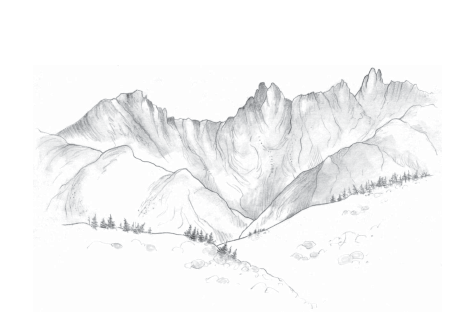 what does he care if he hasnt got any money: he doesnt need any money, all he needs is his rucksack with those little plastic bags of dried food and a good pair of shoes and off he goes and enjoys the privileges of a millionaire in surroundings like this. Jack Kerouac, The Dharma Bums, 1958
what does he care if he hasnt got any money: he doesnt need any money, all he needs is his rucksack with those little plastic bags of dried food and a good pair of shoes and off he goes and enjoys the privileges of a millionaire in surroundings like this. Jack Kerouac, The Dharma Bums, 1958  INTRODUCTION
INTRODUCTION  Homemade Lasagna at 10,000 Feet: Pack to Plate in Three Minutes Youve stopped to make camp after a long day of bushwhacking cross-country in rugged terrain.
Homemade Lasagna at 10,000 Feet: Pack to Plate in Three Minutes Youve stopped to make camp after a long day of bushwhacking cross-country in rugged terrain.
Rain clouds are moving in. You are hungry, really hungry. You want hot food now. Using this book, you can have it: home-cooked, ready to heat and enjoy, one-pot hot meals that youve prepared and dehydrated at home at your leisure during the past year. You pour a packet of homemade Lazy Lasagna into your pot, cover it with water, boil, stir, and enjoy. The thrilling sport of backpacking is more popular than ever.
Backpacking is our passion, but eating well in the wilderness has long been a dilemma. Universally, backpackers need generous portions of good-tasting, nutritious foodfuel that gets you over the passand variety to make mealtimes fun and interesting. Weight and volume are equally important: keep the pack light, with plenty of compact food inside. Commercially freeze-dried meals are light and compact but are often flavorless, expensive, and lacking in stick-to-the-ribs satisfaction, in part because the portions are too small. All of the one-pot recipes in this book make large rehydrated portions: eighteen to twenty ounces per serving. These meals are nearly double the size of most commercial portions, which average only ten ounces per serving when rehydrated.
Perhaps you have bought commercially dried food and read the small print on the label that says, simmer for ten minutes; this translates to twenty minutes or even longer at high altitude. Impossibly heavy canned and fresh ingredients packed into the wilderness are not only a backbreaking burden, but are also time-consuming to prepare. Perishable foodssuch as uncooked eggs, meat, or tofukept at the wrong temperature can make campers very ill. Containers of oil, honey, soy sauce, or other condiments in the backpack are a heavy, messy nuisance. While cooking at home is funwith modern appliances and hot water gushing freely from the tapin the field, an exhausted camper craves easy-to-prepare meals: no mixing, measuring, chopping, sauting, pre-soaking, or simmering. Perhaps you have tried drying fruits and vegetables at home to cook in camp.
Drying ingredients separately and then combining them in the field is tedious and does not yield results as successful as drying complete mealsprotein, grain, and sauceall at once. When these ingredients are dried individually, they need to be soaked, sometimes for hours, before they can be incorporated into a hot meal. Dried peas, for example, can be as hard as pebbles. However, if you use the following recipeswhich contain the right balance of grains, vegetables, protein, and sauceyou will discover that flavorful, nutritious one-pot dried meals can heat fast with no pre-soaking and no work in camp. If you reject boring, expensive meals, or time-consuming, heavyweight cook-in-the-field meals, you do have another choice: dry your own. Since you are simply heatingnot cookingyour home-dried meals in camp, you will use far less fuel: your pack will weigh less.
With a lighter pack, and larger portions of instantly prepared, better-tasting food, your backpacking adventures will soar.  CHAPTER ONE
CHAPTER ONE  HOME-DRIED ONE-POT MEALS
HOME-DRIED ONE-POT MEALS  The ancient art of food dehydration is wonderfully basic. Heat and air circulation remove most of the water content from the food. This lack of water keeps microorganisms from living and growing. After many years of home-drying complete backpack meals, I have never lost food to spoilage. Follow the simple instructions in this chapter and the recipes in chapters two through five of this book and you will enjoy the same success.
The ancient art of food dehydration is wonderfully basic. Heat and air circulation remove most of the water content from the food. This lack of water keeps microorganisms from living and growing. After many years of home-drying complete backpack meals, I have never lost food to spoilage. Follow the simple instructions in this chapter and the recipes in chapters two through five of this book and you will enjoy the same success.
Dehydration is especially suited to backpacking. Not only does drying forestall spoilage, it transforms bulky, heavy food into compact, featherweight meals. Dehydration costs less than any other method of food preservation. It requires no chemicals. Complete meals can be dried year-round in any weather, at your convenience. Take advantage of each seasons bounty, using the finest fresh ingredients available, or use good-quality canned or frozen meat, fish, fruit, or vegetables.
Home-dried meals can be stored for several years. Its easy to keep a ready supply of home-dried dinners on hand for carefully planned extended treks, as well as last-minute weekend escapes. 

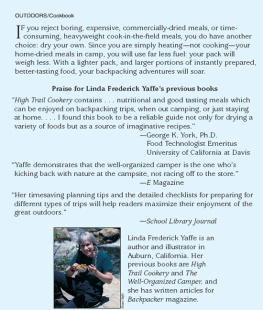
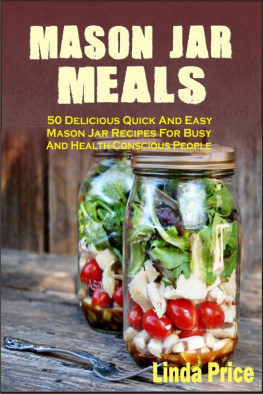

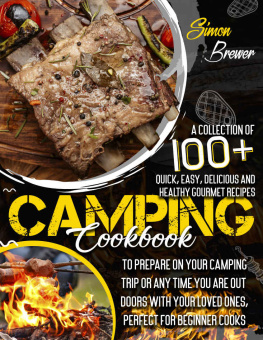

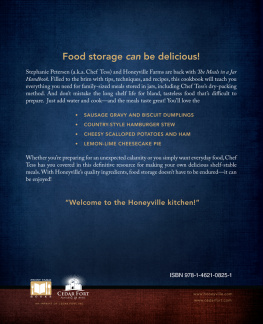
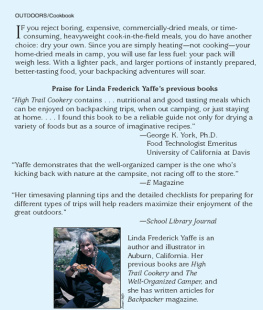
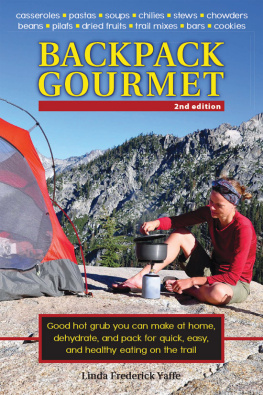


 BACKPACK GOURMET
BACKPACK GOURMET
 what does he care if he hasnt got any money: he doesnt need any money, all he needs is his rucksack with those little plastic bags of dried food and a good pair of shoes and off he goes and enjoys the privileges of a millionaire in surroundings like this. Jack Kerouac, The Dharma Bums, 1958
what does he care if he hasnt got any money: he doesnt need any money, all he needs is his rucksack with those little plastic bags of dried food and a good pair of shoes and off he goes and enjoys the privileges of a millionaire in surroundings like this. Jack Kerouac, The Dharma Bums, 1958  INTRODUCTION
INTRODUCTION  CHAPTER ONE
CHAPTER ONE 